Trauma Center: Second Opinion Review
Trauma Center: Second Opinion
Cutting edge gameplay on the Wii.
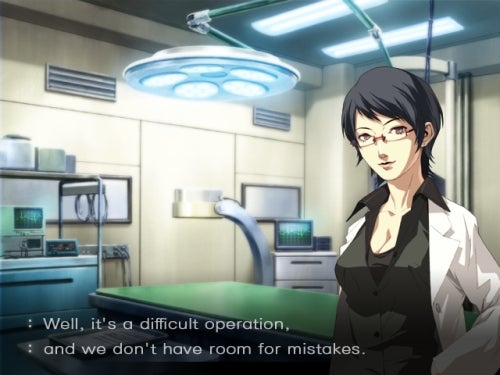
Verdict
Key Specifications
- Review Price: £28.99
One of the great joys of Nintendo’s current hardware has been the way it seems to have set developers free to explore genres and subject matters they have previously ignored. Usually, it seems like game developers live on a steady diet of Sci-Fi, Fantasy and Chuck Norris films, churning out endless variations on the same ‘man on a mission/heroic quest/science tampering with unknown forces’ themes. This leaves a whole range of genres such as melodrama, police procedurals, period drama, political satire and the good old fashioned thriller almost completely unexplored. The DS has done a good job of changing that, taking on legal drama (Phoenix Wright), the gritty detective thriller (Hotel Dusk) and, in Atlus’s Trauma Centre: Under the Knife, the medical drama. These are games that people who don’t normally like games tend to like, partly because – unlike most other games – they actually take on themes and subjects that they already know and love.

Now the Wii is following in its older, smaller brother’s footsteps with an updated version of the aforementioned Trauma Centre. For those of you who haven’t come across it, it’s a sort of streamlined surgical sim where a succession of patients are wheeled in for your attention, and you use a variety of real and fanciful surgical tools to mend their various lacerations, dig out their tumours and remove a variety of foreign bodies from their organs. While all this goes on, comic-book cut-scenes in the excellent Phoenix Wright tradition fill you in on developments and keep you on top of the unfolding central plot.
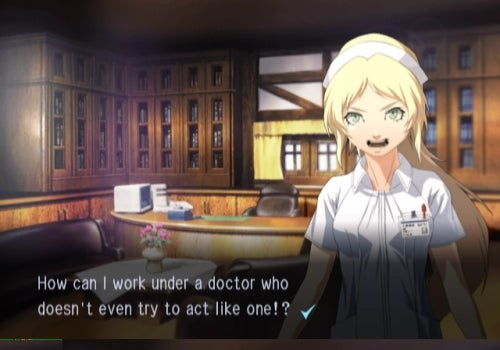
On the DS, this all happened using the stylus, with the bottom screen used for operating and the top screen filled by an assistant who gave regular prompts on the procedure at hand. The Wii, however, has given the game some much-needed room to breathe. The Wii remote now does the actual work on your TV screen, while you select tools using the analogue stick on the attached Nunchuk controller. Meanwhile, your glamorous assistant turns up in the bottom right-hand corner of the screen to prompt your next move or update you on potentially hazardous developments.
At this point in the review, I’d normally moan about how badly the Wii controls have been implemented, but for once I can’t find much cause for complaint. The Wii remote actually makes a fairly precise and speedy surgical instrument, and one of the real pleasures of the game is the way in which Atlus has managed to implement every tool from the forceps (pinched by pressing the A button and B trigger together) to the fluid drain (hold in place and press A to suck) in such a neat and intuitive fashion. In fact, having the tool selection on the nunchuck stick actually makes the game slightly easier, enabling you to switch between tools with a new rapidity, even if it does take a while before you get the hang of picking the right one.
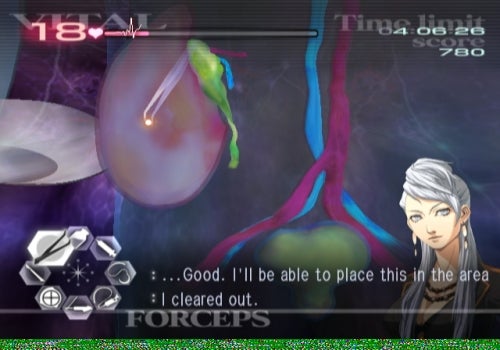
Plus the new platform has even given the developer space to add a few more tasty morsels to the mix, like the handy defibrillators used in a couple of operations, engaged by thrusting the remote and nunchuck forward and pressing the B and Z triggers together. Admittedly the game falters slightly when the controls need you to move objects in and out of the screen, but for the most part this is a rare case of the Wii hardware actually living up to its original promise.
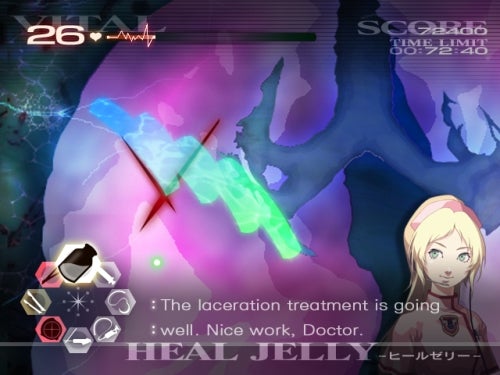
And the basic game mechanics work equally well. Each operation is a relatively short but surprisingly tense affair, as you try to complete each stage of the operation without making a mistake, while giving the patient the occasional shot to keep his vital signs from falling to zero. The operations begin with simple tutorials but grow steadily more complex, and after an hour or so you’ll note that you’re becoming slicker and more practiced with the basics of slicing, removing and suture. Yet each operation still seems filled with a palpable sense of risk and urgency. Sure, it’s irritating that a failure will mean you have to repeat the whole procedure again from the start, but somehow, as the music swells and the panic signals ring out, you can’t help feeling that – dammit – there’s a man’s life at stake!
Of course, as the game goes on it might risk growing stale and formulaic, but Trauma Center sidesteps this neatly by setting the operations within a wider, ongoing plot. After several tricky operations your hero, novice surgeon Derek Stiles, discovers that he has a special abilitiy known in surgical circles as ‘the healing touch.’ Sequestered out to an elite international medical taskforce, it’s not long before he faces the diabolical threat of ‘medical terrorism’ and a series of man-made diseases known as GUILT. These devilish little beggars continually introduce new methods, new problems and new challenges, not least because – unlike a busted heart valve or a big glass splinter – they are able to move and replicate.
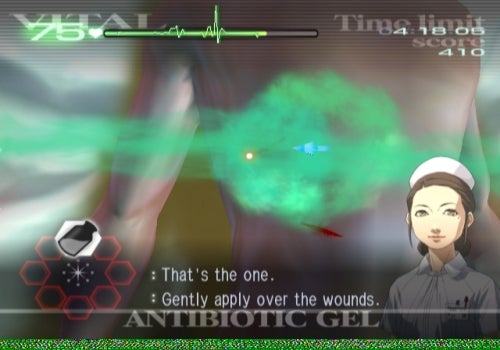
It’s all done in the best anime tradition of cheesy, clichéd characters, overblown dialogue and over-egged plot twists and reversals, but it’s enjoyable and engaging nonetheless. After a while, the game’s alternation between operation and cut-scene makes perfect sense: after each cut-scene you’re intrigued by what the next operation might hold, but once the operation is over you can’t help but wonder where the storyline is going next. After all, how many other games tackle euthanasia or feature a politician who’s willing to die if his death can help save others.
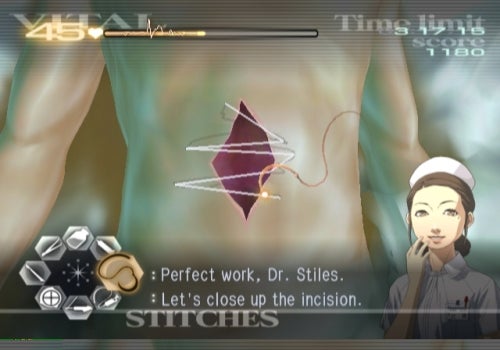
Were this just a reworking of the handheld version all this worryingly addictive nonsense might mean a game you can burn your way through in an afternoon – something that Under the Knife avoided only by some truly hideous difficulty spikes. However, Second Opinion is more than just a port with enhanced graphics. Improved cartoon visuals, the subtle use of 3D objects and a bigger, brighter bolder look make the game a better fit for the big screen, but the real draw here is the comprehensive reworking of many of the existing chapters – including an entirely revamped chapter 6 – and the addition of a second playable character with her own narrative arc.
As she only gets one operation to the five or six otherwise found in each chapter this doesn’t work out to a vast amount of extra content, but the two stories slowly intertwine and the developers have used the extra operations to add in some more neat ideas. What’s not to like about an operation that has to be done under the constraints of torch and flashbulb lighting, or a neat bit of bone-setting using the forceps to twist the various fragments into place?
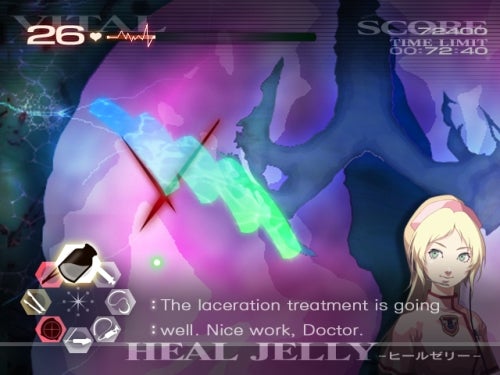
What’s more, having taken six to eight hours to work your way through the storyline, the game doesn’t just stop dead. For one thing, as with the DS version you get a selection of extra special missions to play through, not to mention the opportunity to crack the game at a higher difficulty level. It’s also worth factoring in the ratings dished out when you complete each mission. I’m not usually one for this sort of thing, but once you start getting called a master surgeon and hitting the A or S grades, there’s nothing more galling than to look back through your record and see the Bs and Cs lurking throughout. Must repeat until perfected…..
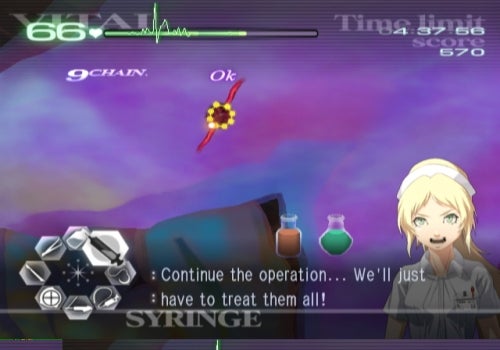
By now you might have the picture that this is one of the best single-player offerings on the Wii, and you’d be right. Like all the best Wii games Second Opinion is accessible and instantly engaging, but unlike so many others this Trauma Centre has legs. It’s still a little too slight to be a classic and the lack of multiplayer options is a shame, but Second Opinion is the sort of game that you’ll want to see through to the bitter end. What’s more, everyone else in your household will doubtless feel the same. It might not be a masterpiece, but this Wii game doesn’t need a second opinion. It’s essential.
”’Verdict”’
A good DS game makes a great Wii title. Like House without the bitter wisecracks or ER without all the personal growth nonsense, Second Opinion is a hugely enjoyable chunk of medical melodrama.
Trusted Score
Features
| PEGI Rating | 12+ |
| Genre | Simulation |
| Player(s) | 2 |

